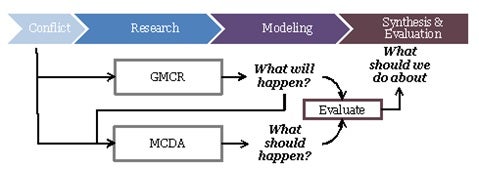Design team members: Spencer Wheatley, Sherif El-Tonbari, & Joshua Aziz
Supervisors: Professor.Keith Hipel
Background
Many academics and environmental groups are concerned that the Canadian government is exploiting the environment to maximize profit. This concern is warranted with Canada reneging on the Kyoto protocol,and following lockstep with the US environmental policy [1]. The development philosophy of the Harper Government may be well summarized by John Thompson, Canadian ecosystem assessment biologist, “We’ll go until it becomes apparent that we’ve gone too far, and then we’ll stop; the canary must die” [2].
The Mackenzie River Basin (MRB) – 20 percent of Canada’s land mass, and one of the last remaining pristine wilderness areas in North America [3] – is being keenly eyed by industry as an opportunity for industrial development. Proposed developments include pipelines, mining operations, and energy generation projects which will promote economic growth, but also disrupt the ecosystemwith their industrial footprint. The Alberta oil sands have already left a scar in the boreal forest which can be observed from space [4].
There are multiple conflicts over proposed industrial development projects in the MRB which have economic benefits and environmental costs. The dispute is between Canadian Industry & Government who support industrial development because they care more about the economy than the environment, and constitutionally protected First Nations groups & environmental groups such as the David Suzuki Foundation who care more about the environment than the economy.Waterloo professors have published research on the MRB environmental conflicts. The implied questionshere are: “what will happen?”, and “who is right? i.e., what should happen?”
Project description
This research focuses on a conflict over the proposed Site C hydroelectric dam on the Peace River in MRB. Among other impacts, it is expected to power 400,000 homes, but also to flood 90 square kilometres of rich boreal forest inhabited by First Nations households [5].
Proponents for construction include the BC government and BC Hydro who want to satisfy growing energy demand among other economic interests [6]. The primary opponents against construction include: First Nations people whosee the project as disruptive to theirconstitutionally protected traditionallifestyle [7], and environmental groups who are critical of its environmental impacts.
Right
now,
BC
Hydro
is
pushing
for
the
construction
of
Site
C,
while
First
Nations
groups
are
attempting
to
stale
this
process
by
threat
of
legal
action,
and
environmental
groups
have
organizes
protests
and
mobilized
public
resistance
against
the
development
of
Site
C.
This
research
aims
to
not
only
answer
the
first
two
questions,
but
also
the
next
logical
question:
“what
should
be
done
about
it?”.
Design methodology
The following framework proposed in this research seeks to combine a number of Systems Design tools including: 1) the Graph Model for Conflict Resolution (GMCR), and 2) Multiple Criteria Decision Analysis (MCDA) – both learned about in SYDE 433 Conflict Resolution.

Figure 1: Research Project Methodology
This framework will be used to analyze the Site C conflict, and answer the questions:
- What’s going to happen?
Using GMCR, an alternative game theory method, the Site C conflict will be modelled, and its future outcome predicted. In the Site C analysis, GMCR will determine if the dam is predicted to be built or not, and how the conflict moves to this point (e.g., legal action by First Nations).
- Who is right / What should happen?
The MCDA, a decision making model, will determine the best outcome for all stakeholders (i.e., everyone impacted by the conflict). In the Site C analysis, the MCDA will consider economic, environmental, societal, and political impacts of the project to determine if the dam should be built or not.This involves hard systems (structured) analysis – e.g., analyzing environmental impacts of Site C – as well as soft systems analysis – e.g., determining the impact upon the First Nations people whose traditional villages would be flooded by the Site C dam reservoir.

- What should be done about it?
Strategic
recommendations
will
be
made
to
ensure
that
the
best
possible
outcome
for
all
stakeholders
is
reached.
In
the
Site
C
analysis,
if
what
is
going
to
happen
(GMCR)
is
not
the
same
as
what
should
happen
(MCDA),
then
intervention
by
a
third
party
(e.g.,
a
government
agency,
or
an
environmental
regulator)
may
be
necessary
to
steer
the
conflict
towards
the
outcome
that
should
happen.
This
intervention
could
be
government
policy,
legal
action,
or
a
research
paper
meant
to
increase
awareness
of
the
issue.
Intense
research
is
necessary
to
accurately
model
the
complex
Site
C
conflict.
Lessons
learned
about
the
Site
C
conflict
may
also
be
extended
to
similar
conflicts
within
the
MRB.
References:
[1]Canadian Press. (2010, December 4). Canada joins Russia, Japan in opposition to extending Kyoto Protocol. Retrieved December 4, 2010, from http://www.thestar.com/news/world/article/901788--canada-joins-russia-japan-in-opposition-to-extending-kyoto-protocol?bn=1
[2]Wood, C. (2010, October). The Last Great Water Fight. The Walrus.
[3] de Loe, R. C. (2010). Transboundary Water Governance in the Mackenzie River Basin, Canada. Waterloo.
[4]The
Conscious
Earth.
(2006,
June
21).
Tar
Sands
from
Space
via
Google
Maps.
Retrieved
December
4,
2010,
from
http://www.canadiangeographic.ca/magazine/jun08/feature_tar_sands.asp
[5] MEMPR. (2010, April 19). Province Announces Site C Clean Energy Project. Retrieved October 10, 2010, from http://www2.news.gov.bc.ca/news_releases_2009-2013/2010PREM0083-000436.htm
[6] MEMPR. (2008, June 13). The BC Energy Plan. Retrieved October 10, 2010, from http://www.energyplan.gov.bc.ca/factsheet/default.htm
[7] Burrows, M. (2010, April 22). Natives plan to fight Site C dam planned for Peace River. Retrieved October 10, 2010, from http://www.straight.com/article-318964/vancouver/natives-plan-fight-site-c